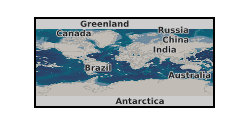Compaction
Type of resources
Topics
Keywords
Contact for the resource
Provided by
Years
Formats
Representation types
Update frequencies
-

These data contain 1) load string compliance mechanical data used to retrieve the absolute sample deformation (Compliance folder); 2) Acoustic emissions data (RawData_AEs folder); 3) Compaction data of the granular packs (RawData_Press folder). These data we used for the publication by Zorn et al., 2024 (https://doi.org/10.30909/vol.07.02.765783). A PDF document detailing further information of the contents of each folder entitled "Zorn_Compaction_Data_Overview" is provided. All data were collected and analysed at LMU Munich on samples from the Eifel Volcanic Field (Germany) and from the Krafla caldera (Iceland). The geographical location of the samples collected is of no relevance to this study, as the samples were selected for their physical attributes. All data were collected and analysed in 2023 and 2024. Loose fragments of volcanic rock from the Eifel Volcanic Field or Krafla caldera were placed in a metal cup and progressively loaded axially to a target load before either 1) removing the load (called "dynamic stressing tests"); or 2) holding the load for 6h or 5 days (called "dynamic followed by static tests"). All experiments were conducted using an Instron uniaxial press, and all displacement data are corrected for the deformation of the loading column (compliance). During each experiment, acoustic emissions sensors attached to the side of the cup to monitor cracking events These data were collected to understand the compaction behaviour of volcanic edifices that consist of interbedded layers of variably loose/coherent materials.
-

These data contain time series of stress, strain, confining pressure, pore pressure, pore volume, permeability and elastic wave velocities of samples of Purbeck Limestone deformed under hydrostatic and triaxial conditions at room temperature. All samples were saturated with decane as pore fluid.This dataset is used and fully described/interpreted in the paper: Brantut, N., M. Baker, L. N. Hansen and P. Baud, Microstructural control of physical properties during deformation of porous limestone, submitted to J. Geophys. Res.
-

Data are either (1) depths and spacings between stylolites and faults within Unit IV, (2) images from IODP drill core image logs of the locations of samples observed, (3) photomicrographs and flatbed thin section scans of thin sections cut from samples, (4) SEM BSE or EDS data collected at Cardiff University. These data form the basis of: Leah et al. "Brittle-ductile strain localisation and weakening in pelagic sediments seaward of the Hikurangi margin, New Zealand", Tectonics, Submitted. Images and data from samples collected at IODP Expedition 375 Site U1520 (38°58.1532'S, 179°7.9112'E, 3522.1 mbsl). This is just seaward (east) of the trench of the Hikurangi Margin, New Zealand.
 NERC Data Catalogue Service
NERC Data Catalogue Service